Six days of yoga, walking, swimming, sightseeing, wildlife (mostly birds and invertebrates), Greek food, and beer on the island of Kythira; what could be better?
Kythira, Cythera, Kythera, and Kithira. In Greek: Κυθηρα
36.2055 years in science communication
You can’t miss the tallest peak in Athens, no not the one with The Parthenon at the top (68 metres elevation), but Mount Lycabettus, also known as Lycabettos, Lykabettos or Lykavittos. In Greek, it’s pronounced “likavi’tos”, so the first three syllables flow as a triplet and the emphasis is on the final beat. It stands at 264 metres.

Second full day on our trip to Athens, we took the funicular railway to the top to see the 19th Century St George’s Chapel and take in the views over the city. I’d have chosen to climb to the top, despite the heat, if I’d realised it was in a tunnel. But, we did walk down and then circumnavigate the pine woodland the begins about half way down and stretches to the base.
One of the things I found intriguing about the name of this hill is the “lika/lyco” prefix, that I thought must refer to wolves in some way, but a couple of Athenians I asked didn’t seem to think so. On Wikipedia, there’s a suggestion that it had an ancient name Lucabetu meaning a mastoid hill, but Wiki also says that the modern name means “walked by wolves”.
Could the original name of this hill be the etymology of the Greek word for wolf, lykos, because that’s where the early Athenians most frequently encountered them? In a similar context, the word lyceum, is definitely connected to the Greek word for wolf, alluding to wolfishness, but referring to a garden of the god Apollo who was said to be wolfish in Greek mythology…
Near-expert friend, Penelope Wilson, tells me she can corroborate, or perhaps, rather complicate! For Lycabettus, apart from the mastoid suggestion others have proposed something to do with luke (light), obviously also associated with Apollo. But, the Ancient Greeks were very good at holding more than one meaning in their heads at a time, and there are puns on Apollo Lukeios as meaning (born from/slayer of) wolves and as god of light. Anyway, she tells me, wolves are definitely there, etymology is attested from classical times. The hill itself was only named or identified with ancient Lycabettus in the 19th C it was previously known as Hill of St George or Mount Aghesmos.
That latter point suggests that the etymology is of the hill’s name not of the word wolf, in that case, but wolfishness is definitely part of the play. It’s still more complicated as Dr Wilson expands via a link to the page for the Lycabettus Run.
Myself and Mrs Sciencebase finally made it back to Greece after far too long a break from that beautiful country. The trip was to be yoga, walking, and wildlife, with plenty of wonderful food, a lot of Greek beer, and far too many photographs. I took the equivalent of eight 36-exposure reels on average each day of a ten-day trip, thank goodness for digital and 64 gigabyte SD cards. Anyway, before we hit the island of Kithira for the aforementioned R&R, we spent three nights in Athens, a place we had meant to visit properly back in the early 1990s, but a trip we missed out on because of ferry delays, force 6 gales, and a 10-30 metre swell!
Here are a few of my snaps from our first couple of days in the Greek capital
The White Stork, Ciconia ciconia, is a scientific tautonym, its binomial being duplicated to indicate that ciconia is the “type”, the archetype, of the family Ciconia. This is the bird of birth myth, the one that bears the infant baby to the homes of expectant parents. Perhaps the myth arose because they build great nests of straw on chimneys in the summer.
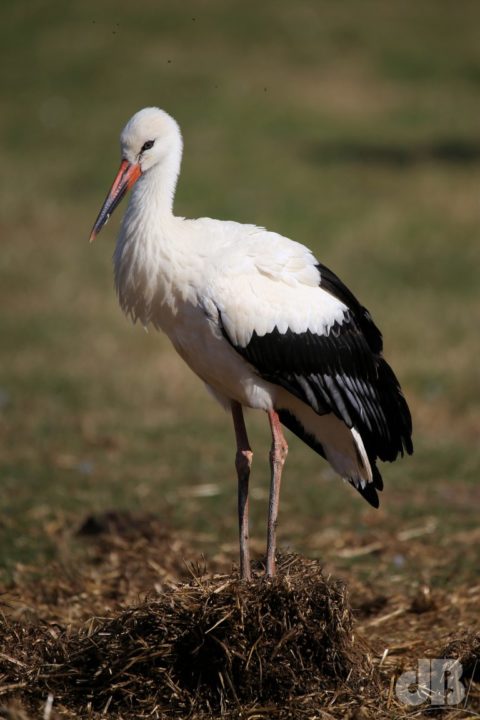
Anyway, the White Stork is rarely seen in The British Isles. You might see them nesting on rooftops in Germany, Poland, Finland, and beyond. They are relatively common across Europe and not of conservation concern, wintering in southern Africa and breeding far and wide into Europe and Asia. They need thermals to soar and so cross from Africa via the Straits of Gibraltar and “The Levant” rather than attempting to navigate the Mediterranean Sea, which obviously doesn’t produce the thermals they need.
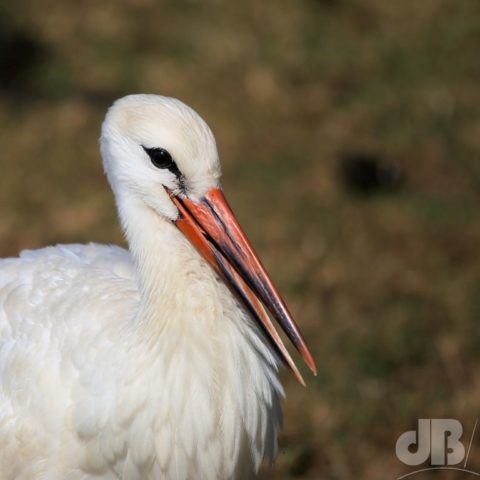
There was much excitement among Cambridgeshire birders when a ringed bird was spotted at a couple of RSPB sites, Ouse Fen and Fen Drayton, in April 2018 and another (the same one?) sighted in various places across the county in early 2019.
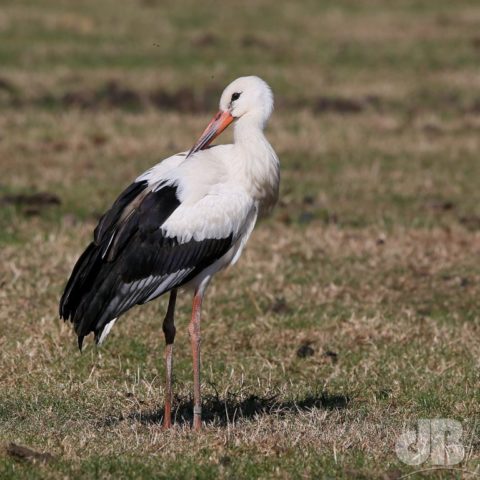
There is a small flock of captive, ringed White Storks at Johnson’s Farm in Old Hurst, the farm with the crocodiles. My photos on this blog post were all snapped at the farm on Talk Like a Pirate Day 2019. Aharrgh.
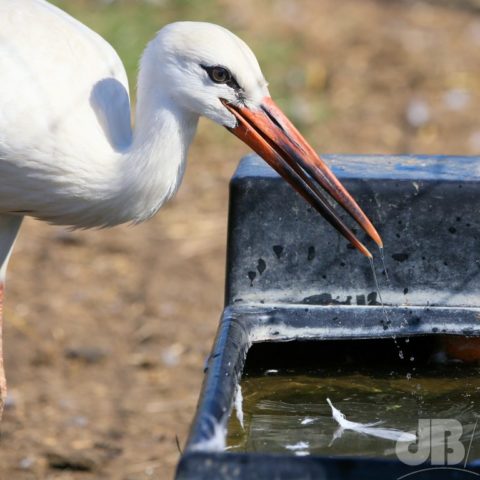
It’s Talk Like a Pirate Day, which holds a special place in the hearts of Mrs Sciencebase and myself that has nothing to do with Dubloons, wooden legs, nor eyepatches. Nevertheless, a day out at a local farm seemed a sensible way to celebrate, hahah. So, we headed into deepest, darkest Huntingdonshire, we met no one on the way to St Ives (not that one), flew around RAF Wyton, headed for Pidley (birthplace of our long-gone feline) and took a sharp left after a U-turn to Johnson’s Farm in Old Hurst.

Now, Johnson’s farm has sheep and cows, a butchery, and a farm shop and cafe. But, it also has Macaws and Emus, Meerkat(s), Capybara, giant rabbits, and (not seen) Wallabies. It also has a flock of about 7 or 8 Storks, a bird species that like the Gene Genie loves chimney stacks, but usually those of continental central and eastern Europe rather than the British Isles. Johnson’s also has some tropical birds, a boa constrictor, oh and there is something else…crocodiles.
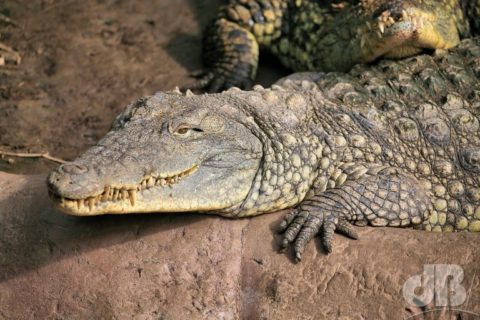
The crocodiles are I believe part of a conservation, breeding programme, but from the aforementioned working farm and butchery point of view, they are the most efficient means of disposing of the tons of butchery waste generated each year. which has crocodiles…I don’t know if any of them have a ticking alarm clock in their stomach.
They’re not quite as cute as the Horsey seals, maybe not quite as watchable as the birds I photograph, and definitely not as up-close-and-serious as the moths. But, they are, you must admit, rather photogenic in an almost tropical prehistoric way…needles to say, I got a few snaps.


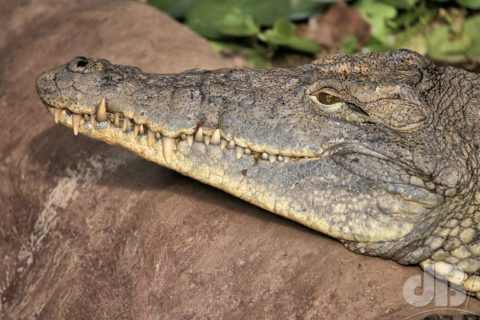
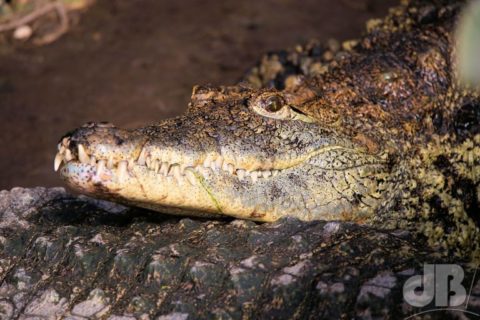
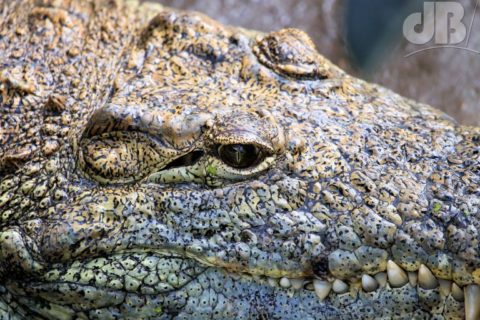
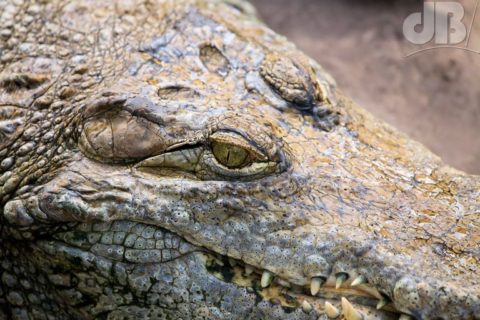
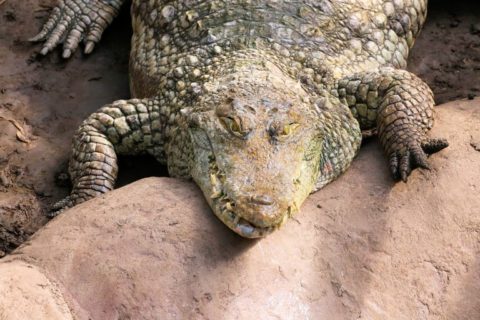
I’ve seen Hummingbird Hawk-moths, Macroglossum stellatarum, on a few occasions but previously when travelling abroad (specifically, Croatia (2017), Germany (2018), and Italy (2010), and if memory serves many years ago France, 1996). I’ve only ever got awkward, blurry, and low-resolution photos. Earlier in the summer, a friend gave me some red valerian plants, which are a favourite of this species; same friend who donated the snails for our newly resurrected pond, #pondlife.
That was back in early June. I had high hopes of seeing swarms of this bird-like Lep, which is an immigrant to the UK but occasionally seen in numbers when there’s an irruption. But, it seemed like it wasn’t to be, until this balmy September day (just 17 Celsius in the shade though). Finally, a HBHM has turned up. Initially, I wasn’t quick enough with my camera, but at least I saw it before it headed off over our roof. But, then twenty minutes later it was back, or perhaps it’s a second one. I was ready. Shutterspeed 1/4000th of a second, still not fast enough to freeze the moth’s wings in flight, but at least you get the gist.
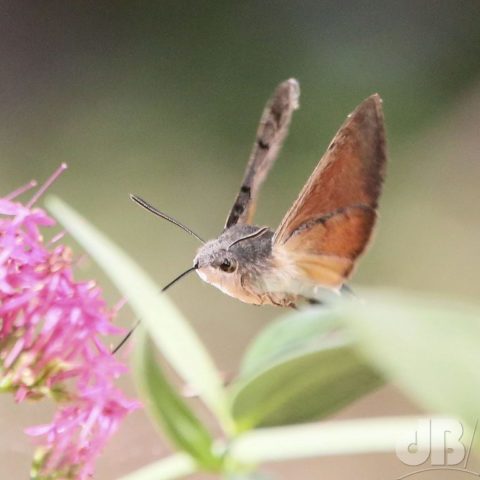
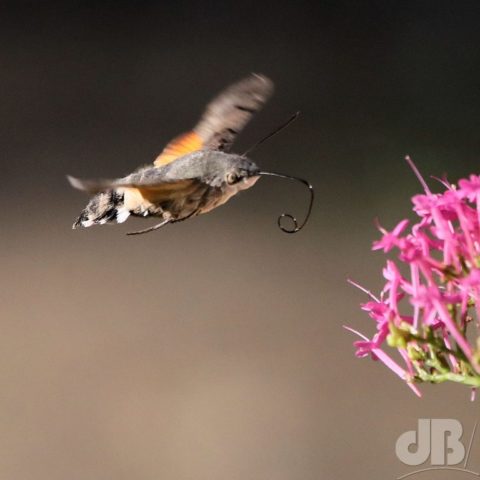
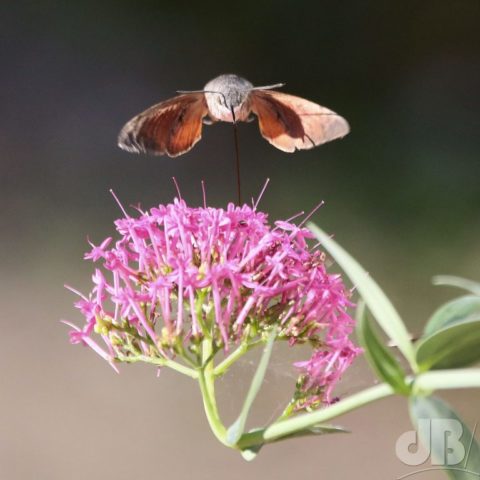
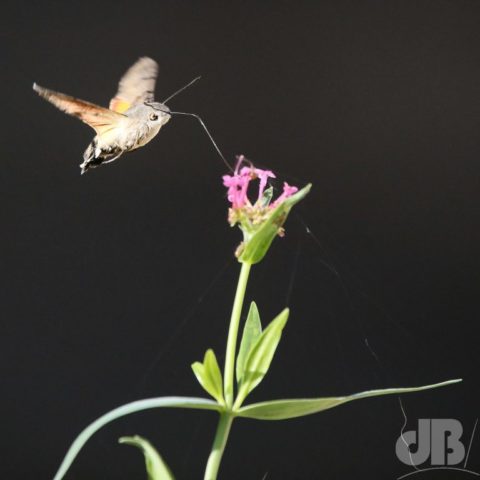
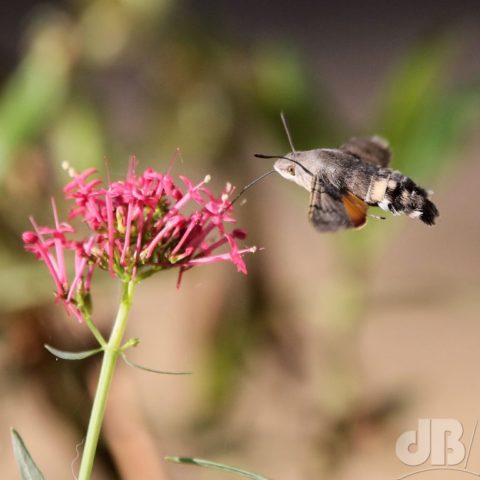
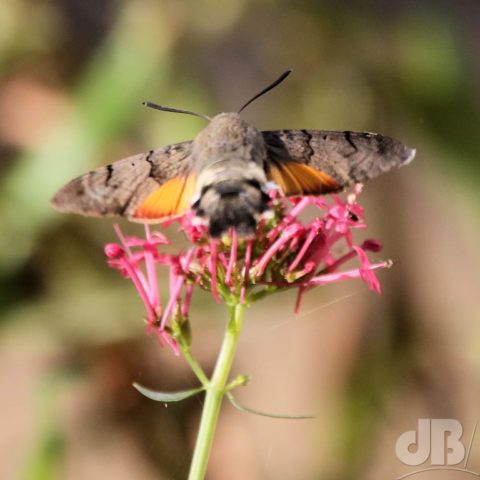
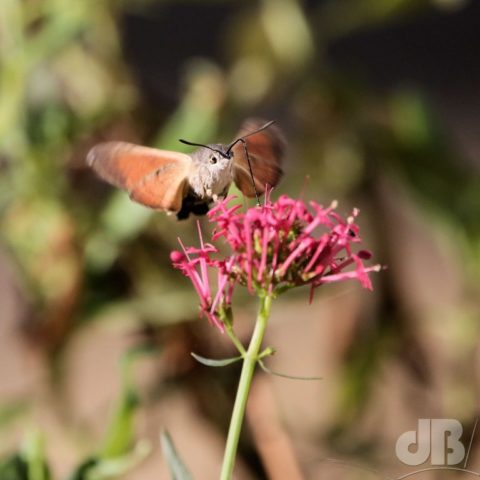
 The moth mothers often abbreviate as the SHC, the Setaceous Hebrew Character, Xestia c-nigrum, turns up a lot in scientific traps from late summer into the autumn. The name refers to a marking on its forewings that resembles the Hebrew letter, nun, and the setaceous means “bristly” and refers to the hairs around the character. Hence my tongue-in-cheek reference to it being the Bristly Nun. The setaceous separates it from a distant relative but fellow noctuid, the spring-flying Hebrew Character, Orthosia gothica, it has the nun, but is clean-shaven and so lacks those bristles.
The moth mothers often abbreviate as the SHC, the Setaceous Hebrew Character, Xestia c-nigrum, turns up a lot in scientific traps from late summer into the autumn. The name refers to a marking on its forewings that resembles the Hebrew letter, nun, and the setaceous means “bristly” and refers to the hairs around the character. Hence my tongue-in-cheek reference to it being the Bristly Nun. The setaceous separates it from a distant relative but fellow noctuid, the spring-flying Hebrew Character, Orthosia gothica, it has the nun, but is clean-shaven and so lacks those bristles.
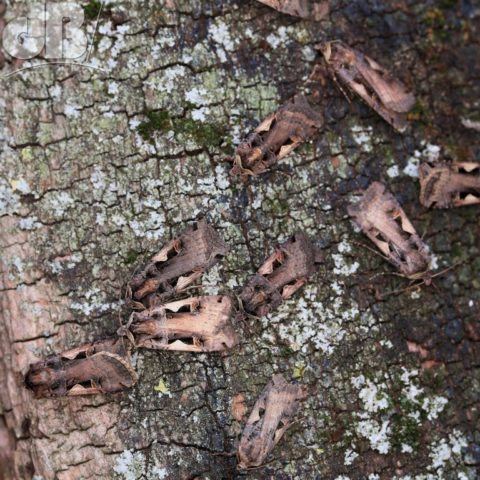
The SHC also flies in its first brood from May to June, but the second brood seems to be far more numerous August to September. You can see from my records for 2019 here that I’ve seen hundreds, with a peak in August of well over 100 on a single night. Nothing compared to the numbers of fellow noctuid the bombastic Large Yellow Underwing, Noctua pronuba. Apart from subtle variation in marking definition and some size difference, the SHCs mostly look alike. Again, in contrast to N. pronuba, which can vary considerably in their choice of browns and greys.
Anyway, there were no NFY (new for year) moths in the trap this morning, so I focused on the SHC on a whim and placed a small tribe of those from the haul on to my trusty chunk of mossy and lichen-covered bark for a quick photoshoot and a macro closeup or two.
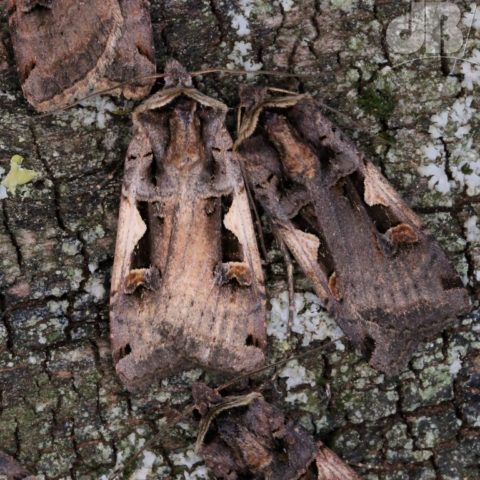
Large Thorn, Ennomos autumnaria, attracted to the UV lamp of the scientific trap, night of 16th September, didn’t get a chance to enter the trap before I potted it to photograph this NFM*.
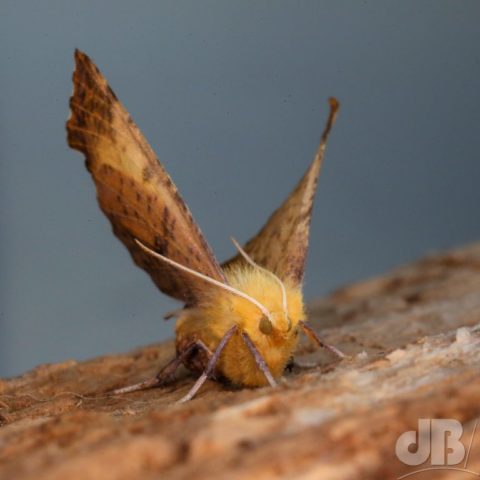
The species, like the other geometers we know as Thorns looks like an autumnal leaf, and occasionally quivers when roosting as if to follow the breeze. It’s a relatively large moth, but the “Thorn” of its vernacular name refers to a spike on the larva and is nothing to do with the adult being at all prickly.
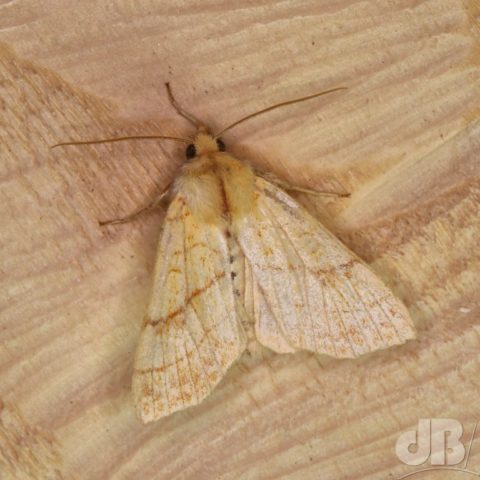
Also around the trap at the same time a worn Orange Sallow (worn, but NFM*) and a Centre-barred Sallow, both very autumnal in appearance.
*NFM = New for me
First appearances in 2019 of various moth species to the scientific trap. Some of these were new for the year (NFY) as I’d seen them in 2018. Some were NFM, new for me.
17 Sep Large Thorn
17 Sep Orange Sallow
15 Sep Clepsis consimilana
15 Sep Beautiful Hook-tip
13 Sep Brown-spot Pinion
13 Sep Barred Sallow
10 Sep Common Marble
7 Sep Centre-barred Sallow
4 Sep Feathered Gothic
4 Sep Eudonia angustea
3 Sep Yellow-line Quaker
25 Aug Frosted Orange
25 Aug Jersey Tiger
7 Aug Straw Underwing
6 Aug White-spotted Pinion
5 Aug The Lychnis
5 Aug Rosy Rustic
5 Aug Wax Moth
4 Aug Twin-spotted Wainscot
4 Aug Pale Prominent
4 Aug Flounced Rustic
4 Aug Red Underwing
30 Jul Yellow-tail
28 Jul Peacock
27 Jul Mouse Moth
27 Jul Oak Eggar
27 Jul Square-spot Rustic
26 Jul Acrobasis suavella
26 Jul Argyrotaenia ljungiana
26 Jul Blastobasis adustella
26 Jul Bordered Pug
26 Jul Garden Rose Tortrix
26 Jul The Crescent
26 Jul Small Scallop
25 Jul Canary-shouldered Thorn
25 Jul Common Carpet
22 Jul Acleris forsskaleana
21 Jul Buff Footman
21 Jul Tree-lichen Beauty
18 Jul Copper Underwing
17 Jul Codling Moth
17 Jul Dusky Sallow
17 Jul Garden Dart
17 Jul Bulrush Wainscot
17 Jul Small Emerald
13 Jul Celypha striana
13 Jul Hypsopygia glaucinalis
13 Jul Ypsolopha scabrella
12 Jul Barred Straw
12 Jul Straw Dot
12 Jul Least Broad-bordered Yellow Underwing
12 Jul Box-tree Moth
11 Jul Bordered Sallow
11 Jul Coronet
11 Jul The Herald
11 Jul Lozotaeniodes formosana
11 Jul Marbled Clover
11 Jul Rhyacionia pinicolana
10 Jul Straw Dot
10 Jul Ruby Tiger
9 Jul Meal Moth
7 Jul Small Ranunculus
6 Jul Buff-tip
6 Jul Old Lady
5 Jul Green Silver-lines
5 Jul Lesser/Common Rustic agg.
5 Jul Rose-flounced Tabby
3 Jul Brown-tail
3 Jul Clay
2 Jul Brown-line Bright-eye
1 Jul Morophaga choragella
1 Jul Single-dotted Wave
1 Jul Flame
27 Jun Buff Arches
26 Jun Phoenix
26 Jun Yellow Shell
26 Jun Rustic/Uncertain
26 Jun Small Grey
25 Jun Rhodophaea Formosa
25 Jun Smoky Wainscot
25 Jun Oak Lantern
25 Jun Bramble shoot Moth
24 Jun Barred Yellow
24 Jun Donacaula forficella
24 Jun Elder Pearl
24 Jun Ringed China-mark
24 Jun Swallow-tailed Moth
24 Jun Varied Coronet
23 Jun Dwarf Cream Wave
22 Jun Broad-barred White
22 Jun Clouded Silver
22 Jun Double Square-spot
22 Jun Scorched Wing
22 Jun Thistle Ermine
21 Jun Spinach
21 Jun Lilac Beauty
21 Jun Scalloped Oak
20 Jun Cochylis atricapitana
20 Jun Common Footman
19 Jun Light Arches
19 Jun Mottled Beauty
19 Jun Freyer’s Pug
19 Jun Pyrausta aurata
19 Jun Udea olivalis
19 Jun White Satin Moth
18 Jun Chrysoteuchia culmella
17 Jun Crassa unitella
17 Jun White Plume
16 Jun Agapeta hamana
16 Jun Large Fruit-tree Totrix
15 Jun Foxglove Pug
15 Jun The Shark
14 Jun The Snout
14 Jun Fenland Pearl
13 Jun Bordered White
13 Jun Least Carpet
12 Jun Swallow Prominent
10 Jun Small Elephant Hawk-moth
9 Jun Pale Mottled Willow
8 Jun Gold Spot
8 Jun Green Pug
8 Jun Hawthorn Moth
8 Jun Setaceous Hebrew Character
6 Jun Silver Ground Carpet
6 Jun Privet Hawk-moth
6 Jun Riband Wave
6 Jun Brown House Moth
6 Jun Hook-streak Grass-veneer
4 Jun Peppered Moth
4 Jun Large Nutmeg
3 Jun Elephant Hawk-moth
2 Jun Poplar Grey
2 Jun Burnished Brass
2 Jun Treble Brown Spot
2 Jun Gold triangle
2 Jun Spruce Carpet
1 Jun Small Magpie
1 Jun Dark Arches
1 Jun Buff Ermine
31 May Eyed Hawk-moth
31 May Large Yellow Underwing
29 May Cinnabar
27 May White Ermine
23 Jun Dwarf Cream Wave
28 May White-point
27 May Garden Pebble
26 May Tawny/Marbled Minor agg.
23 May Willow Beauty
22 May Treble Lines
21 May Light Brocade
21 May Oak Hook-tip
20 May Bee Moth
20 May Common Pug
20 May Twenty-plume
20 May Common Marbled Carpet
20 May Apotomis betuletana
20 May The Shears
20 May Common Swift
20 May Dingy Footman
19 May Small Dusty Wave
19 May Broad-bordered Yellow Underwing
19 May Pale Tussock
18 May Rustic shoulder-knot
18 May Chocolate Tip
18 May Lime Hawk-moth
18 May Small Clouded Brindle
17 May Flame Shoulder
15 May Coxcomb Prominent
15 May Puss Moth
14 May Heart & Club
14 May White-shouldered House-moth
9 May Vine’s Rustic
8 May Heart & Dart
8 May Light Emerald
8 May Yellow-barred Brindle
3 May Clouded Border
1 May Angle Shades
27 Apr Latticed Heath
25 Apr Maiden’s Blush
24 Apr Turnip
24 Apr Bright-line Brown-eye
24 Apr Least Black Arches
23 Apr Lime-speck Pug
23 Apr Iron Prominent
22 Apr The Spectacle
22 Apr The Nutmeg
22 Apr Pebble Prominent
22 Apr Waved Umber
21 Apr Brimstone
21 Apr Sallow Kitten
21 Apr Beautiful Plume
21 Apr Chinese Character
20 Apr Cabbage Moth
20 Apr Scorched Carpet
19 Apr Red Twin-spot carpet agg.
18 Apr Nut-tree Tussock
18 Apr Pebble Hook-tip
17 Apr Streamer
11 Apr Muslin
7 Apr Shuttle-shaped Dart
20 Mar Emperor
29 Mar Early Thorn
24 Mar Garden Carpet
20 Mar Chestnut
20 Mar March Moth
16 Mar Silver Y
14 Mar Diurnea fagella
14 Mar Double-striped Pug
10 Mar Pale Pinion
9 Mar Dotted Border
8 Mar Early Grey
6 Mar Twin-spotted Quaker
4 Mar Small Quaker
1 Mar Clouded Drab
24 Feb Oak Beauty
23 Feb Hebrew Character
23 Feb Pale Brindled Beauty
22 Feb Common Plume
22 Feb Light-brown Apple Moth
22 Feb Acleris cristana
20 Feb Common Quaker
As autumn rolls on the number of specimens and the diversity of moths to the scientific trap tend to fall. The dedicated keep lighting up for rarities, vagrants, and of course, the Sallows, the Thorns, later the Merveille du Jour moths and then the December Moths.
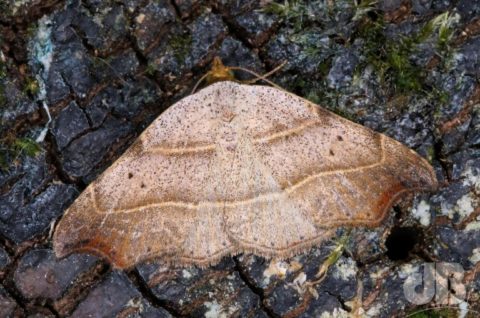
That said, it was warm yesterday and stayed balmy all night (minimum of 16 Celsius) albeit a bit wet at some point. So, 93 specimens of 24 species, which is quite a high for mid-September, I think especially given that it was down to 10 species of 35 moths previous trapping night.
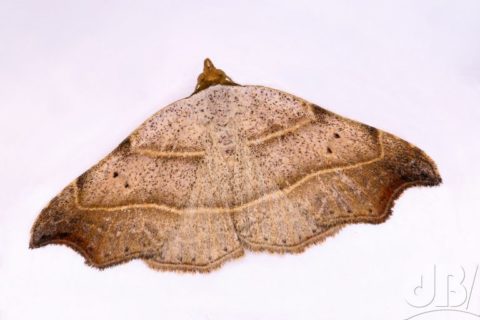
A new one for me was Beautiful Hook-tip (Laspeyria flexula). It flies June to August and then a small, second brood emerges in September. Increasingly common, the larvae eat lichen growing on a wide range of trees.
Now, some people might wonder why this one is called the Beautiful Hook-tip. Well, it’s got those hooked tips to its wings. but is it beautiful? It certainly is, like any creature created by millions of years of evolution, but also just look at the symmetry, the geometry, the subtle colours and hues of those wings, especially the rusty edges of the forewings curving inwards from their hooked tips. How can you not see that as beautiful?